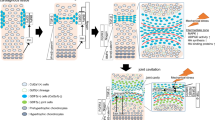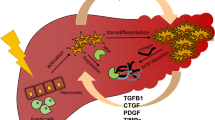Abstract
Recently, the role of cytokines in controlling gene expression of connective tissue components has been increasingly emphasized. Many cytokines have been shown to have specific effects on gene expression of connective tissue components, and the roles of cytokines in controlling connective tissue metabolism during wound healing and in fibrosis have increasingly been discussed. In this article, the effects of cytokines on regulation of gene expression of connective tissue components, especially of type I collagen were described. We analysed transcriptional control of the α1(I) collagen gene by TNF-α by means of DNA mediated transfection experiments using recombinant plasmids in which the promoter region of the human α1(I) collagen had been fused to the chloramphenicol acetyl-transferase (CAT) gene, in human dermal fibroblasts. It was found that TNF-α reduced α1(I) collagen transcription through at least up to −107 bp upstream of the human α1(I) collagen promoter gene in dermal fibroblasts.
Similar content being viewed by others
References
Allen-Hoffman BL, Schlosser SJ, Brondyk WH, Fahl WE (1990) Fibronectin levels are enhanced in human fibroblasts overexpressing the c-sis protooncogene. J Biol Chem 265: 5219–5225
Balkwill FR, Burke F (1989) The cytokine network. Immunol Today 10: 299–304
Bassols A, Massague J (1988) Transforming growth factor Β regulates the expression and structure of extracellular matrix chondroitan/dermatan sulfate proteoglycans. J Biol Chem 263: 3039–3045
Blatti SP, Foster DN, Ranganathan G, Moses HL, Getz MJ (1988) Induction of fibronectin gene transcription and MRNA is a primary response to growth-factor stimulation of AKR-2B cells. Proc Natl Acad Sci USA 85: 1119–1123
Clore JN, Cohen IK, Diegelmann RF (1979) Quantitation of collagen types I and III during wound healing in rat skin. Proc Soc Exp Biol Med 161: 337–340
Crombrugghe B de, Vuorio T, Karsenty G (1990) Control of type I collagen genes in scleroderma and normal fibroblasts. Rheum Dis Clin North Am 16: 109–123
Fleischmajer R (1977) The pathophysiology of scleroderma. Int J Dermatol 16: 310–318
Gauss-Müller V, Kleinman HK, Martin GR, Schiffmann E (1980) Role of attachment factors and attractants in fibroblast chemotaxis. J Lab Clin Med 96: 1071–1080
Gorman CM, Moffat LF, Howard B (1982) Recombinant genomes which express chloramphenicol acetyl transferase in mammalian cells. Mol Cell Biol 2: 1044–1051
Graves PN, Wess IK, Perlish JS, Fleischmajer R (19833) Increased procollagen mRNA levels in scleroderma skin fibroblasts. J Int Rheumatol 80 : 130–132
Grotendorst G, Martin GR (1986) Cell movement in woundhealing and fibrosis. Rheumatology 10: 385–403
Heldin P, Laurent TC, Heidin H-C (1989) Effect of growth factors on hyaluronan synthesis in cultured human fibroblasts. Biochem J 258: 919–922
Ignotz RA, Massague J (1986) Transforming growth factor-Β stimulates the expression of fibronectin and collagen and their incorporation into the extracellular matrix. J Biol Chem 261: 4337–4345
Jimenez S, Feldmann G, Bashey R, Bienkowski R, Rosenbloom J (1986) Coordinate increase in the expression of type I and type III collagen genes in progressive systemic sclerosis fibroblasts. Biochem J 237: 837–843
Johnson RL, Ziff M (1976) Lymphokine stimulation of collagen accumulation. J Clin Invest 58: 240–252
Jones KA, Yamamoto KR, Tjian R (1985) Two distinct transcription factors bind to the HSV thymidine kinase promoter in vitro. Cell 42: 559–572
KÄhari V, Vuorio T, NÄnto-Salonen K, Vuorio E (1984) Increased type I collagen mRNA levels in cultured scleroderma fibroblasts. Biochim Biophys Acta 181: 183–186
KÄhari VM, Multimaki P, Vuorio E (1987) Elevated pro-α2(I) collagen messenger RNA levels in cultured scleroderma fibroblasts result from an increased transcription rate of the corresponding gene. FEBS Lett 215: 331–334
KÄhÄri V-M, Sandberg M, Kalimo H, Vuorio T, Vuorio E (1988) Identification of fibroblasts responsible for increased collagen production in localized scleroderma by in situ hybridization. J Invest Dermatol 90: 664–670
Kang AH (1978) Fibroblast activation. J Lab Clin Med 92: 1–4
Keska-Oja J, Raghow R, Sawdey M, Loskutoff DJ, Postlethwaite SE, Kang AH, Moses HL (1988) Regulation of the mRNAs for type I plasminogen activator inhibitor, fibronectin, and type I procollagen by transforming growth factor-Β. J Biol Chem 263: 3111–3115
Krieg TH, Hein R, Hatamochi A, Aumailley M (1988) Molecular and clinical aspects of connective tissue. Eur J Clin Invest 18: 105–123
Ksander GA, Ogawa Y, Chu GH, McMullin H, Rosenblatt JS, McPherson JM (1989) Exogenous transforming growth factor-beta 2 enhances connective tissue formation and wound strength in guinea pig derma wounds healing by secondary intent. Ann Surg 211: 288–294
Kulozik M, Hogg A, Lankat-Buttgereit B, Krieg T (1990) Colocalization of transforming growth factor beta2 with alpha1(I) procollagen mRNA in tissue sections of patients with systemic scleroderma. J Clin Invest 186: 917–922
Kurita K, Hashimoto J, Takei T, Kawai T, Hayakawa T (1985) Changes in collagen types during healing of rabbit tooth extraction wounds. J Dent Res 64: 28–32
Kurkinen M, Vaheri A, Roberts PJ, Stenman S (1980) Sequential appearance of fibronectin and collagen in experimental granulation tissue. Lab Invest 43: 47–51
LeRoy EC (1981) Scleroderma (systemic sclerosis). In: Kelley WB, Ruffy S, Sledge LB (eds) Textbook of rheumatology. W. B. Saunders
Le Roy EC, Smith EA, Kahaleh MB (1989) A strategy for determining the pathogenesis of systemic sclerosis. Arthritis Rheum 32: 817–825
Levenson SM, Geever EF, Crawley LZ, Oates JF, Berard CW, Rosen H (1965) The healing of rat skin wounds. Ann Surg 161: 293–308
Lynch SE, Nixon JC, Colvin RB, Antoniades HN (1987) Role of platelet-derived growth factor in wound healing: synergistic effects with other growth factors. Proc Natl Acad Sci USA 84: 7696–7700
Lynch SE, Colvin RB, Antoniades NH (1989) Growth factors in wound healing. J Clin Invest 84: 640–646
Madden JW, Peacock EE (1968) Studies on the biology of collagen curing wound healing: I. Rate of collagen synthesis and deposition in cutaneous wounds of the rat. Surgery 64: 288–294
Madden JW, Peacock EE (1971) Studies on the biology of collagen during wound healing: III. Dynamic metabolism of scar collagen and remodelling of dermal wounds. Ann Surg 174: 511–522
MÄkelÄ, Vuorio E (1986) Type I collagen messenger RNA levels in experimental granulation tissue and silicosis in rats. Med Biol 64: 15–22
Mauch C, Krieg T (1986) Pathogenesis of fibrosis — introduction and general aspects. Rheumatology 10: 372–384
Mustoe TA, Pierce GF, Thomason A, Gramates P, Sporn MB, Deuel TF (1987) Accelerated healing of incisional wounds in rats induced by transforming growth factor-Β. Science 237: 1333–1335
Paul WE (1989) Pleiotropy and redundancy: T cell-derived lymphokines in the immune response. Cell 57: 521–524
Peacock EE Jr (1984) Wound repair, 2nd edn. W. B. Saunders, Philadelphia
Peltonen J, KÄhÄri L, Jaakkola S, KÄhÄri V-M, Varga J, Uitto J, Jimenez SA (1990) Evaluation of transforming growth factor beta and type I procollagen gene expression in fibrotic skin diseases by in situ hybridization. J Invest Dermatol 94: 365–371
Penttinen RP, Kobayashi S, Bornstein P (1988) Transforming growth factor Β increases mRNA for matrix proteins both in the presence and in the absence of changes in mRNA stability. Proc Natl Acad Sci USA 85: 1105–1108
Pierce GF, Mustoe TA, Lingelbach J, Masakowski VR, Griffin G, Senior RM, Deuel TF (1989) Platelet-derived growth factor and transforming growth factor Β induce in vivo and in vitro tissue repair activities by unique mechanisms. J Cell Biol 109: 429–440
Pierce GF, Tarpley JE, Yanagihara D, Mustoe TA, Fox GM, Thomason A (1992) Platelet-derived growth factor (BBhomodimer), transforming growth factor-Β1, and basic fibroblast growth factor in dermal wound healing. Am J Pathol 140: 1375–1388
Raghow R, Postlethwaite AE, Keski-Oja J, Moses H-L, Kang AH (1987) Transforming growth factor-beta increases steady state levels of type I procollagen and fibronectin messenger RNA's posttranslationally in cultured human dermal fibroblasts. J Clin Invest 79: 1285–1288
Roberts AB, Sporn MB, Assoian RK, Smith JM, Roche NS, Wakefield LM, Heine UI, Liotta LA, Falanga V, Kehrl JH, Fanci AS (1986) Transforming growth factor type beta: rapid induction of fibrosis and angiogenesis in vivo and stimulation of collagen formation in vitro. Proc Natl Acad Sci USA 83: 4167–4171
Ross R (1968) The fibroblast and wound repair. Biol Rev Camb Philos Soc 43: 51–96
Rossi P, Karsenty G, Roberts AB, Roche NS, Sporn MB, de Crombrugghe B (1988) A nuclear factor 1 binding site mediates the transcriptional activation of a type I collagen promoter by transforming growth factor Β. Cell 52: 405–414
Scharffetter K, Lankat-Buttgereit B, Krieg T (1988) Localization of collagen mRNA in normal and scleroderma skin by in situ hybridization. Eur J Clin Invest 19: 9–17
Scharffetter K, Heckmann M, Hatamochi A, Mauch C, Stein B, Riethmüller G, Ziegler-Heitbrock J, Krieg T (1989) Synergistic effect of tumor necrosis factor-alpha and interferon-gamma on collagen synthesis of human skin fibroblasts in vitrol Exp Cell Res 181: 409–419
Scharffetter K, Kulozik M, Stolz W, Lankat-Buttgereit B, Hatamochi A, Söhnchen R, Krieg T (1989) Localization of Collagen α1(I) gene expression during wound healing by in situ hybridization. J Invest Dermatol 93: 405–412
Solis-Herruzo JA, Brenner DA, Chojkier M (1988) Tumor necrosis factor α inhibits collagen gene transcription and collagen synthesis in cultured human fibroblast. J Biol Chem 263: 5841–5845
Sprugel KH, McPherson JM, Clowes AW, Ross R (1987) Effects of growth factors in vivo. I. Cell ingrowth into porous subcutaneous chambers. Am J Pathol 129: 601–613
Takeda K, Hatamochi A, Arakawa M, Ueki H (1993) Effects of tumor necrosis factor-α on connective tissue metabolism in normal and scleroderma fibroblast cultures. Arch Dermatol Res 284: 440–444
Varga J, Rosenbloom J, Jimenez SA (1987) Transforming growth factor beta (TGF-Β) causes a persistant increase in steady-state amounts of type I and type III collagen and fibronectin mRNA's in normal human dermal fibroblasts. Biochem J 297: 597–604
Wahl SM, Wahl LM, McCarthy JB (1978) Lymphocyte-mediated activation of fibroblast proliferation and collagen production. J Immunol 121: 942–946
Author information
Authors and Affiliations
Rights and permissions
About this article
Cite this article
Hatamochi, A., Mori, K. & Ueki, H. Role of cytokines in controlling connective tissue gene expression. Arch Dermatol Res 287, 115–121 (1994). https://doi.org/10.1007/BF00370729
Received:
Issue Date:
DOI: https://doi.org/10.1007/BF00370729




